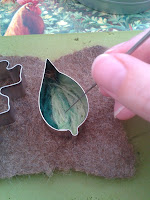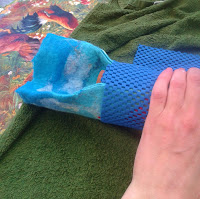First you need to measure your hand at the widest part with your thumb lightly tucked in. This will ensure that you can get your bracelet on once made. You need to halve then add 30% to this measurement. So if your hand measures 20cm around, you need to halve it (10cm) then add 30% to give 13cm.
Then decide how wide you want your bracelet to be and add 30%. I want mine about 6cm, so I make it approximately 9cm. The 30% extra is because your wool will shrink. If you're not using merino wool, check what the shrink rate is.
Cut out two card templates with these measurements and pop them on a piece of non-slip mat. I have two oblongs measuring 13cm by 9cm.
I'm using this poppy design for inspiration. You could make your bracelets all one colour or several different colours. Use anything and everything to inspire you for pattern and colour.
Lay down the first layer of wool. This should overlap by a centimetre or two either end. Try not to go too much over the edge of the template at the top and bottom. I just used the basic underlying colours in this first layer. Repeat for a second layer. In felting you should lie the layers perpendicular to each other. However, because my bracelet is quite narrow, I lay my next layer slightly diagonally so my green doesn't go into my blue.
The next layer I added horizontally. I added some different shades of blue and green to this layer.
Then it's time to add the decoration! I used silk noil to add clouds and red nepps for the poppies.
Once you're happy with your design lay over a piece of fine net (you could also use a piece of dust sheet). Sprinkle some hand hot, soapy water in the middles of your designs. I used a small watering can for this. The idea is for the wool to all be wet, but not so water is leaking out the sides. I do this on my dining table with a waterproof cloth over the top no problem. If you accidentally use too much water just mop it up with a towel. If you use too much water or soap the fibres will just float past each other and not felt.
Gently press through the net and spread the water across the design, except for the edges that go off the side of the template.
Once it's all wet, very carefully peel off the net.
At this stage I added some blobs of red wool and damped them down into the design to make my poppies.
I put some black nepps in the centre of each.
Carefully flip your bracelets over.
Fold down both sides with a bit of water. If you have any overlapping bits at the top and bottom then fold these under themselves. You should still be able to see the card at the top and bottom. This is where your hand goes through.
Repeat all the stages again for the other side.
Then fold over the sides. You might have to lift up and reposition some elements of your design where they overlap. I had to pick up some of my poppies and clouds.
Your water is probably quite cool by now, so either reheat in the microwave in a microwaveable container, or get fresh.
Replace the net over the design. Mop up any excess cold water with a towel through the net if you need to and replace with hand hot, soapy water.
Start pressing gently at first though the net. Imagine you're stroking a baby rabbit. If any of your design gets dislodged you can repostition it at this stage.
Gradually build up the pressure of your hands, making sure you pay attention to the sides of the bracelet. Run your fingers down the edge, otherwise you'll end up with thin bits coming off the edge. Turn your bracelet over periodically.
Keep going, this bit takes quite a while. Reheat your water if it gets cool.
Once you can pinch a section of your felt without fibres coming free you're ready for the next stage.
Roll your design up in the non-slip matting with a rolling pin. Then roll that up within an old towel.
Roll the whole thing backwards and forwards about fifty times. Make sure you roll it the whole way from your elbow to your hands to ensure the whole design is under pressure.
You can see here the design is already beginning to shrink from the rolling.
Flip the bracelets around and roll the other way.
After 50 rolls in each direction I removed the card templates. You might have to gently pull apart the top and bottom if any fibres have overlapped here.
Now get some soapy water and rub around inside and on the open edges as these areas may be less well felted.
Then return to the rolling! Keep rolling the bracelets in all different directions. Add more hot water if it gets cool. Make sure you check for sizing as you go, you don't want it to shrink too small.
Once you are happy with the size of your bracelets and you can pull the felt in all directions without stretch you're done.
Rinse the bracelets in warm water then soak in cold water with a dash of white vinegar for about 15 minutes.
Squeeze the water out (but don't wring) then leave to dry.
Your bracelets are finished!
You can but theses cuffs and more at my website
www.apulina.co.uk












































